Hard Corps: Uprising Review
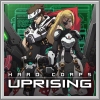 Game: Hard Corps Uprising
Game: Hard Corps Uprising
Developer: Arc System Works
Publisher: Konami
Available on: Xbox LIVE Arcade and PlayStation Network (XBLA version reviewed)
In 1987 arcades were exposed to a new run and gun action game from Konami. Two playable characters Bill and Lance – crack Commandos – tasked with the mission of taking down a terrorist cell which is plotting to take over the world – Red Falcon. Equipped with unlimited ammo and eight directions to shoot in, the game provided precision control. Two-player co-op and a variety of weapon upgrades added further excitement. And with no energy bars to help you out and one-hit kills to avoid at every turn, the game stood up as an extremely challenging title. And so Contra was born.
The latest title from Konami – Hard Corps: Uprising – is a spin-off from the Contra universe and shares many of its most recognisable traits, but will it share its quality and enduring popularity? Read on to find out.
STORY: In the year 2613 and the world is controlled by Tiberius, the leader of an evil collective known as the Commonwealth Empire. In response to the oppression that has swept the land, many resistance groups have come together. They have had little success so far, but now Commonwealth soldier and former war hero, Bahamut, has defected to the cause of the rebels, after witnessing his squad execute a group of innocent villagers. In the hope that he can help save many more innocent lives, he and the insurgents form a last-ditch plan to take down the empire.
Players can choose to control either Bahamut or comrade Krystal – an untrained soldier who joins the revolution after the imperial forces decimate her hometown. The story development is kept to a minimum, with new narrative details only being revealed in loading screen text between stages. As with other games of the genre, gameplay takes priority over plot to a large extent. Bosses in each level are often introduced in this text, but as we have no prior knowledge of who they are (or where they fit into the story) their impact is unfortunately minimised and they largely just become faceless enemies. Cut=scenes are non-existent really, aside from intro and outro videos, further illustrating the lack of emphasis put on the storyline.
GRAPHICS: For a side-scrolling action game – which plays out almost completely in two dimensions – the graphics remain rather impressive. Character and enemy sprites are all hand-drawn in a sci-fi anime style, which allows for some great expressions and characterisation – even at such a small scale. Fluid animations and fast, vibrant action is pulled off impressively by the art style and is always interesting to look at.
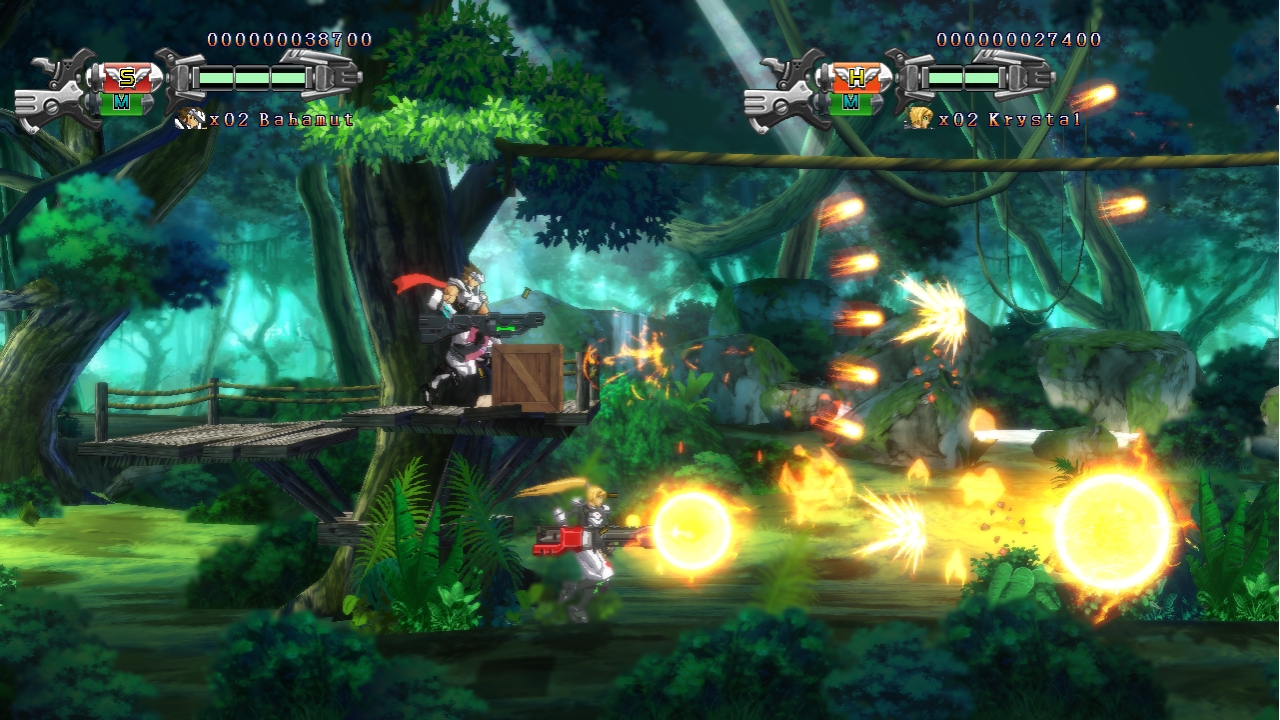
The game plays almost entirely in two dimensions because the environments and background embellishments exist in several planes of depth – almost a 2.5D view. This seems to be a popular choice when developers re-make or update classic game styles for the current market. If the toss-up is between making the game fully 3D – and therefore losing the crux of the core gameplay – or being made in pseudo 2.5D and remaining incredibly playable and maintaining the spirit of the original games, I would personally choose the latter every time. The use of several background planes means there is always something happening and that only adds to the frantic nature of the game. You must always be on your toes, keeping an eye open for enemies, and the addition of these background details only increases the confusion over where the next attack is coming from.
The stages all have a very distinct character and have lots of features unique to that particular area, this means that the level design is always varied. Full colour palettes are used and the game actually looks far more interesting than many of the past entries in the Contra series. Whereas a lot of the past games in the series were very industrial and futuristic, the environments in this game vary between traditional jungles and cities, there are also those which take place in the desert and ancient tombs – adding to the variety of art on display.
SOUND: The sound is certainly nothing revolutionary for the genre, the music consisting of mainly frantic Japanese thrash metal and frantic techno-rock. Although perhaps produced to a higher standard, this is more or less what a player would expect to encounter when playing a game of this type.
Voices are used sparingly, for deaths cries and power-up pickups, but even so, they tend to become repetitive. For instance, you will hear the same screams coming from your enemies in the throes of death around twenty of thirty occasions in just one stage. Sound effects are effective and reminiscent of retro titles. The pulsing sound of the gunfire, for instance, sounds like it could be straight out of a sci-fi blockbuster, but also contains memories of playing run-and-gun shooters in the arcades of the late nineteen-eighties.
GAMEPLAY: Anyone who has played past Konami shooting games like Rush’n’Attack or the earlier Contra games will pick up this title and be able to play it immediately. In fact, the old-school gameplay is so simple that anyone would be likely to understand it and master most of the mechanics in short order. The basic run, jump and shoot buttons are present and players can still shoot in any direction they want. It is surprising how many games on Xbox LIVE Arcade for example still limit gamers to only being able to shoot up, down, left or right. Konami got their system right first time, and didn’t mess around with it.
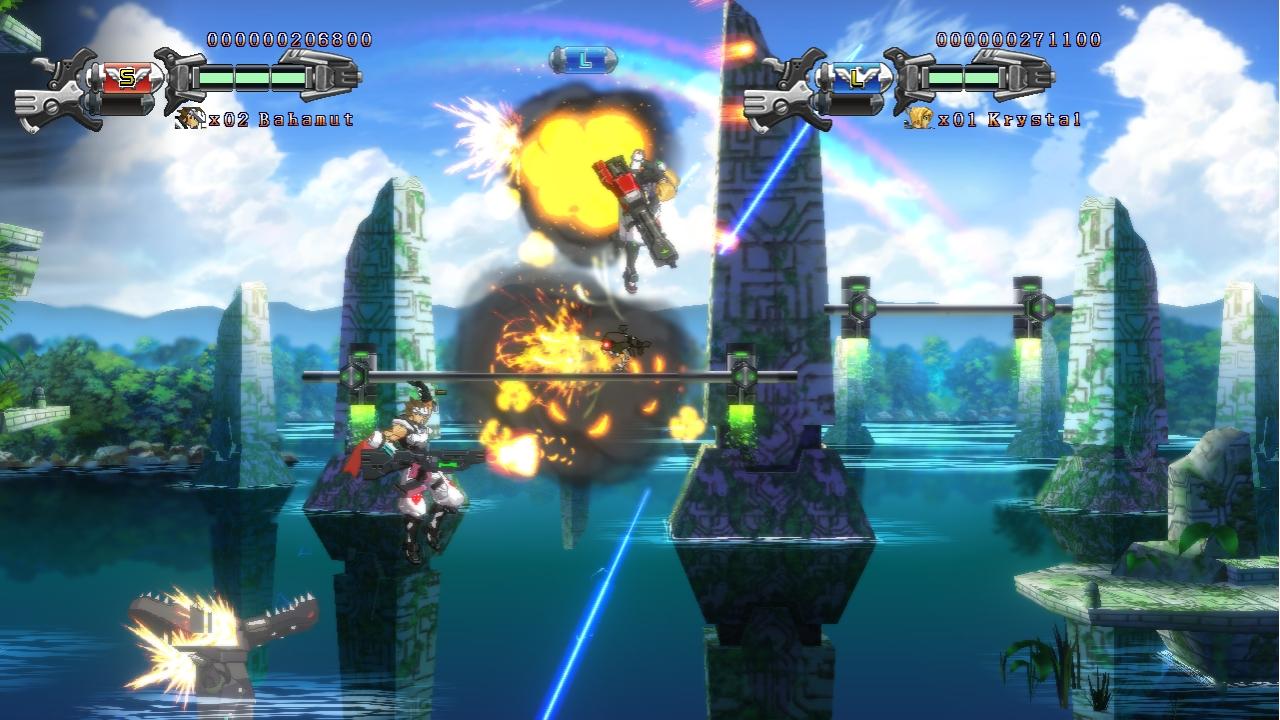
Certain concessions to modern gaming have been added, such as the near-constant feature of modern gaming – the double-jump. This of course makes tricky jumps easier, but also opens the title up to a greater variety of platforming elements – where trickier jumps or those which involve a change of direction in mid-air are made possible.
The main compromise the developers have added is the option to play through the game in either Arcade or Rising modes. Arcade mode is the traditional experience, which basically means it is damn hard. You will die, many times. One hit from an enemy will result in you losing a life and your supply of them is anything but endless. Also, every single time you start an Arcade mode game you have no choice but to start playing from the very first mission. This is the unadulterated, hardcore Hard Corps experience. This is what the Konami run-and-gun games have always been famous for and that is no different here.
Rising mode however is more forgiving. Players have life bars, so that they can take several hits before losing a life. This, of course, stretches each life out somewhat and allows players to survive through levels slightly more easily. In addition to this, players can re-start or pick-up their game from any level they have previously reached the next time they boot up the title. This obviously means that you won’t have to play Rising mode through from start to finish in one sitting. The biggest addition though is probably the shop and upgrade mode. As players move through the game, kills and power-ups will add to their high-score – which translates into spendable money in the shop. This can be put towards purchasing more sections for your life bar or more overall lives. Also, weapon upgrades and special actions can be bought to add more variety in the ways you can take down your enemies.
The actions players can perform (once unlocked) include a basic dash, mid-air dash, bullet deflection and special tackle – amongst others. These obviously can only be used in certain situations or against particular enemies, but when used wisely they can make some portions of the game far less stressful. Weapons in the game include such Contra standards as the Spread Shot and Heavy Machine Gun, as well as newer ones like the Chain Laser (homes in on enemies) and the Crush Gun (a hand-held short-range mortar). Two weapons can be held at one time and switched at will, but special guns are lost if your character takes even one hit. Multiple pickups of the same weapon will upgrade shot speed and power for that weapon.
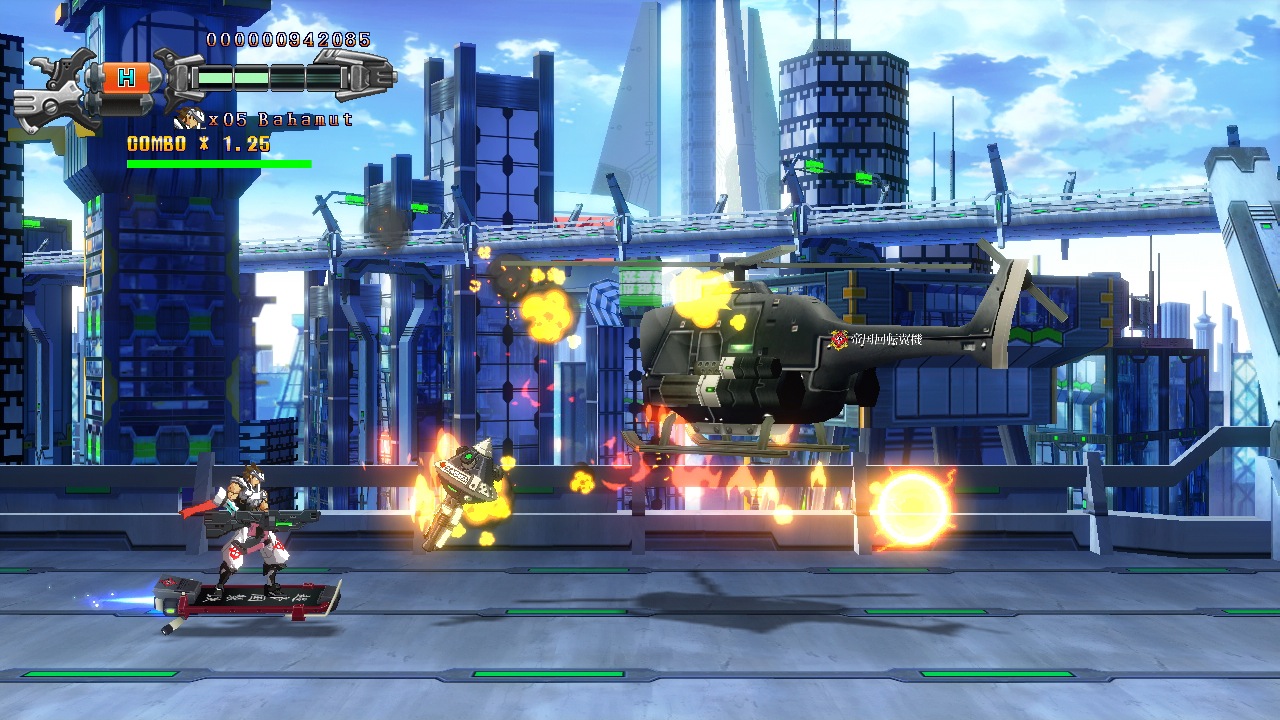
Despite all of these additions, the main issue most players would have with the gameplay in this title remains the difficulty. The game is still unrelenting and constantly frantic. The in-game action starts off at high-speed and rarely slows down. The first level is in fact harder than stage 2 and 3 combined, but that isn’t saying they are easy by any means. As players perfect the techniques and special actions, the regular sections of levels will become less bothersome. However, when you factor in the bosses (of which there are usually two or three per level) and vehicle sections, you are still going to find the game rather challenging.
Bosses are generally pattern-based, so can be learnt and bested through multiple playthroughs – that is assuming you haven’t lost too many lives in reaching the boss. Several bosses will require the player to still have a good supply of lives as some of their attacks are near-enough impossible to dodge. Vehicle levels, however, can be completely horrible and frustrating. These often move so fast that the players’ eyes can barely keep up with what is happening on-screen at any one time. Before you know it, an enemy will have appeared and sprayed multiple bullets across the screen, leaving you little time to react. Vehicle stages have long been the bane of these types of games. The third stage in Super Nintendo side-scrolling action title Battletoads, for example, was fiendish. The same sentiment applies to Hard Corps: Uprising, you will play vehicle based stages more than once. To complete these devilish stages you are pretty much required to learn each jump and dodge like your life depended on it…seriously.
MULTIPLAYER: Co-op gameplay is available both on the same machine and via online play. This has long been a feature of the genre and thankfully has been left in, so you and a chum can slog through the perilous levels together. Players can pick from either of the two characters or play as the same one, wearing different colours. Whilst the game is certainly a lot of fun in multiplayer, the nature of the frustrating play is likely to lead to arguments – so be forewarned! In fact, in several instances – such as the boss fight at the end of level three – having two players makes the experience more confusing and it is almost impossible to follow all the bullets on-screen. But play the boss in single player and it seems you have more time to judge your jumps and the lack of another distraction on-screen makes it somewhat easier. That isn’t the only way multiplayer makes the game more difficult – you will share continues in this mode too, so prepare yourself for less chances to start over on a tricky stage.
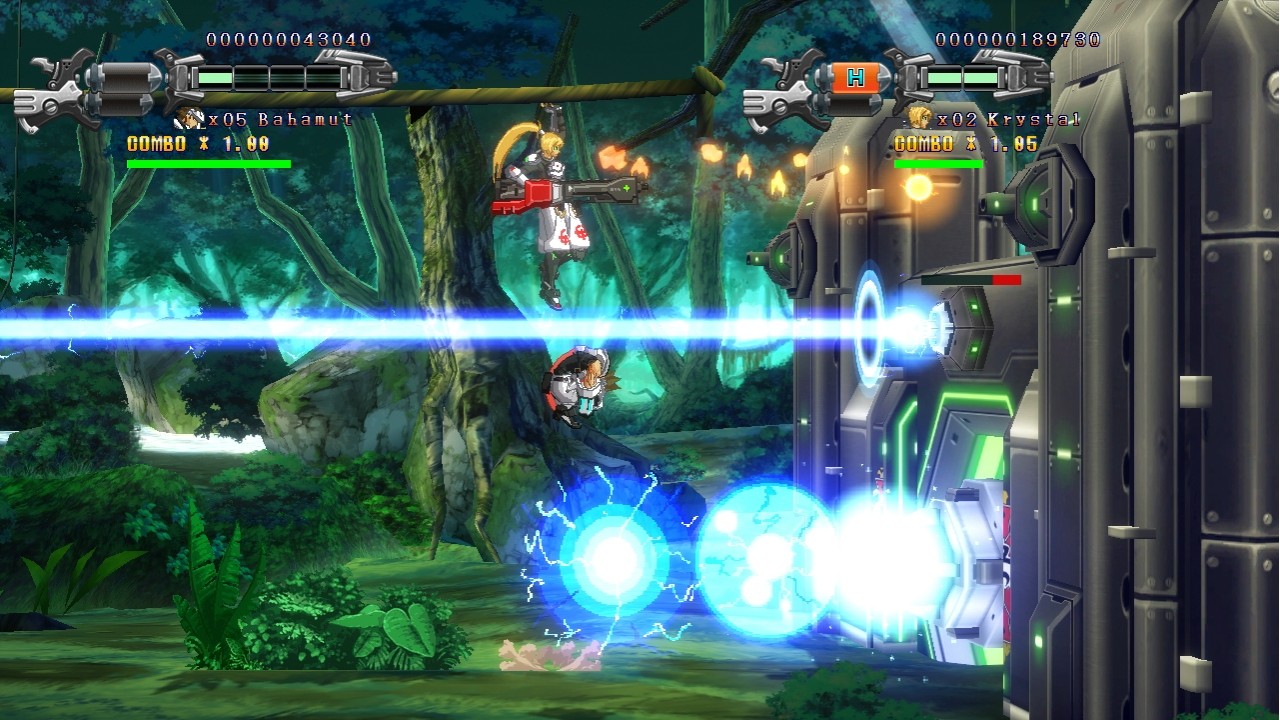
Online play can be initiated through party mode on the Xbox 360 version, which is a nice feature to have, but seems somewhat redundant in a game where only two players can take part. You have no real need to form a party as matching two players into the same game is a fairly straightforward procedure. Online functions are rounded off by an in-game marketplace (for future DLC) and another bastion of retro games, leaderboards! Yes, if you are hardcore enough to make it through the game and defeat the evil Commonwealth, you will definitely want to show off your scores and grades attained on each level to the world.
LONGEVITY: Due in a large part to the difficulty of the game, this will likely last you a long time. Eight levels don’t sound like very many, but compared to the length of levels in other similar games, most of the stages present here are around double the standard expected.
When you factor in the Arcade mode, which is effectively the games hard difficulty, you are greeted with an added layer of longevity. You might think, “do I really want to play the whole game through again after clearing it?”. However, the majority of achievements or trophies only unlock when playing the Arcade mode. So, if you want to increase your gamerscore or grab those shiny trophies, you are going to have to step up your game and get really hardcore.
VERDICT: Hard Corps Uprising adds to the growing list of retro or retro-inspired games that populate Xbox LIVE Arcade and the PlayStation Network. The enduring popularity of the genre is proven by the huge success on these platforms of other run-and-gunners such as Shadow Complex and Alien Hominid – to name just two. To add to that, thank to the long-standing popularity and quality of Contra games, this title is bound to spark a lot of interest.
The gameplay is as solid as it has ever been and, if anything, it is probably slightly more accessible than before, thanks to the dispensations that have been made to cater for the modern gamer. The improved art style and presentation only makes it a more attractive prospect to potential buyers. However, that the steep difficulty curve does mean that this game won’t be to the taste of every gamer. It certainly isn’t a bad thing that it is so hard, it is just an acquired taste that many gamers have become un-accustomed to. In a somewhat casual gaming environment, this is one title that is most definitely aimed at the hardened veterans. Hard Corps by name, hardcore by nature.





